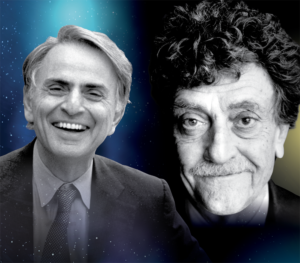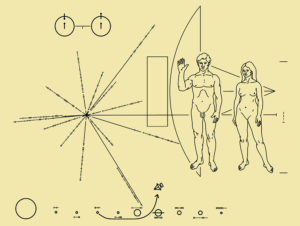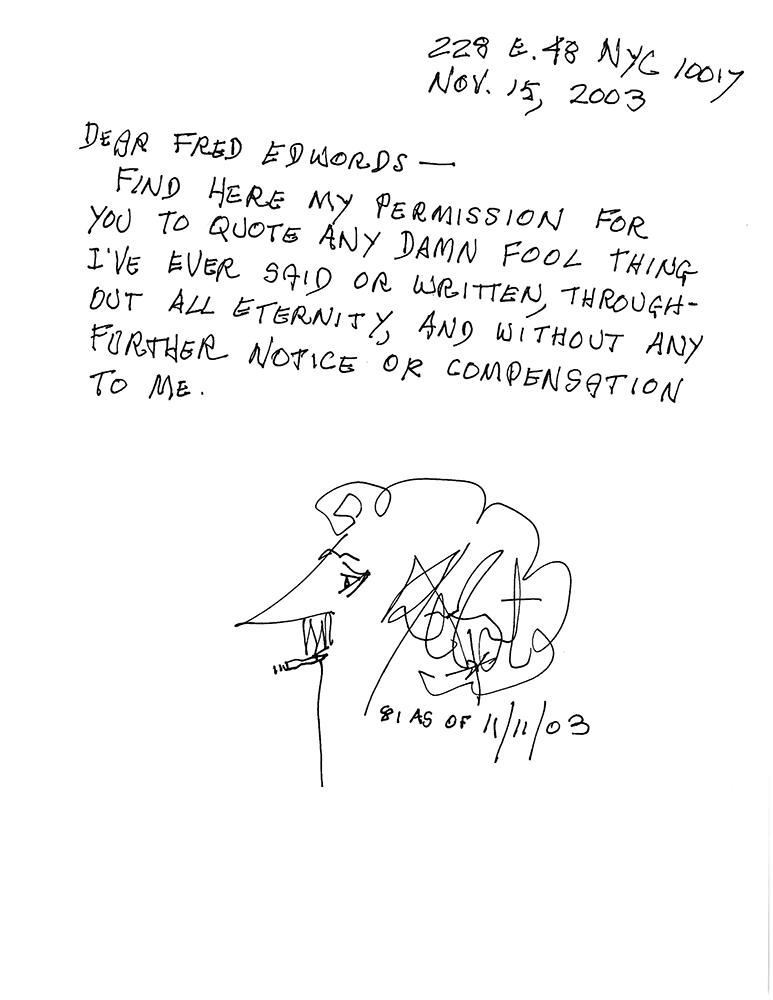Two Good Humans: The Friendship Between Carl Sagan and Kurt Vonnegut
 Image source: Michael Okoniewski
Image source: Michael Okoniewski CARL SAGAN FIRST ENTERED KURT VONNEGUT’S ORBIT IN 1966. The satirist was working at the time as a creative writing professor at the University of Iowa Writer’s Workshop and the heavy teaching load was taking its toll on his creative energies. “It is spiritually pooping,” he wrote to an editor friend, “to care desperately about student work that probably isn’t worth caring about.”
Vonnegut was also working on his novel Slaughterhouse-Five at Iowa, but he found time to grab a few extra bucks freelancing. One magazine, Life, gave him some print space to review Intelligent Life in the Universe, a surprising four-year, cross-cultural collaboration between Carl Sagan and Russian astronomer Iosef Shmuelovich Shklovskii, completed in the thick of the Cold War and Space Race. The book had been Shklovskii’s to begin with in Russian, but when Sagan was given the opportunity to add to the English translation, he ended up changing the book entirely in the hopes of reaching the general public. Vonnegut, a writer forever concerned with communicative clarity, appreciated this. He wrote in his review:
Of the two collaborators it is the American astronomer who is the more humane writer, who, with friendly, wry little asides, acknowledges that the reader might, for good reasons, be nauseated and scared stiff. Dr. Sagan has seen fit to include as illustrations, along with flabbergasting photographs of galaxies and double stars, cartoons by Charles Schulz and Charles Addams which relate human beings (and Snoopy) to the universe humbly.

Vonnegut’s famous asterisk
In the Life review, Vonnegut also appreciates Sagan’s sense of humor, especially when he compares the expanding universe to “an unbaked raisin cake.” The analogy could have come from Vonnegut’s pen. Sagan writes in the book:
Each raisin represents a galaxy. The cake is placed in an oven and, after a while, it rises. The volume of the cake has increased—that is, the “universe” has expanded—but, in addition, there has been an increase in distance from any raisin to any other raisin. If we were to stand on a raisin and view the other raisins, it would appear that all the other raisins were receding from us, and that the most distant raisins were moving away at the greatest speed.
Hungry?
Safe to say, Vonnegut loved the humanist Sagan’s perspective (less so the more rigidly accurate Shklovskii). “They patiently explain to me again,” writes Vonnegut, “what I am too dumb to understand ever: why hearts and clocks naturally slow down as they approach the speed of light, why time on spaceships isn’t anything like time on my mantelpiece.”

The Pioneer Plaque, an image co-designed by Sagan and placed on board the Pioneer spacecraft in the early 1970s.
It is quite possible that the name Kurt Vonnegut entered Carl Sagan’s orbit much earlier. Sagan loved The Sirens of Titan, published in 1959. Vonnegut’s second novel, it is now famous for the author’s invention of “chrono-synclastic infundibula,” described as “places…where all the different kinds of truths fit together…”
Sagan may have smiled at this concept, but it was the “epistemological” elements in Titan that captivated the young scientist. Calling it “superb,” Sagan commended Vonnegut for vividly realizing a “not-altogether-inclement environment…postulated on Saturn’s largest moon.” Sagan went on, writing for The New York Times in 1978:
When in the last few years some planetary scientists, myself among them, presented evidence that Titan has a dense atmosphere and perhaps higher temperature than expected, many people commented to me on the prescience of Kurt Vonnegut.
Sagan was happy to give Vonnegut his due, but he wanted to give the novelist even more. It wasn’t that Vonnegut had simply imagined this other world without any educational background. No, Sagan thought of Vonnegut as a fellow man of science. “Vonnegut,” wrote Sagan, “was a physics major at Cornell University [where Sagan taught] and naturally knowledgeable about the latest findings in astronomy.”
Writer Bill Sternberg, a 1978 Cornell graduate, dug through Carl Sagan’s archives at the Library of Congress and found some brief correspondence between the two humanists. “It was perhaps inevitable,” wrote Sternberg, “that Cornell’s most famous scientist and its most famous dropout, both best-selling authors, would cross paths.” In 1977 Sagan, remembering Vonnegut’s positive Life review, sent Vonnegut a copy of The Dragons of Eden: Speculations on the Evolution of Human Intelligence, which went on to win the Pulitzer Prize. Vonnegut, Sternberg reveals, loved the book. “You make it so easy for a lazy person like me to have some inkling, all the same, of what may really be going on.”
Vonnegut was even more impressed with Sagan’s help on the 1976 Viking lander missions to Mars. “I owe you a lot,” he wrote from his home in New York on February 28, 1977, “since the landings on Mars have been the greatest poems of all time.”
Sagan also sent back to Vonnegut a few words regarding Tralfamadore, a fictional planet Vonnegut most famously used in Slaughterhouse-Five. Tralfamadorians
were two feet high, and green, and shaped like plumber’s friends. Their suction cups were on the ground, and their shafts, which were extremely flexible, usually pointed to the sky. At the top of each shaft was a little hand with a green eye in its palm. The creatures were friendly, and they could see in four dimensions. They pitied Earthlings for being able to see only three. They had many wonderful things to teach Earthlings about time.
Vonnegut, in a 1977 letter, sent Sagan a new Tralfamadore message, perhaps material he’d later use in the novel Hocus Pocus. Here is Sagan’s reply:
Dear Kurt:
Many thanks for your cheerful letter and the message from the Tralfamadorians. I’ve always argued that decoding an interstellar message will be the easiest part of our task; but I’m not sure that the Tralfamadorian message could be put in a form that we terrestrial astronomers could interpret without some considerable effort on our parts. But it would certainly be a message of some substance!
In all their writings, it was vital for Sagan and Vonnegut to offer kind, humane and clear communication to their readers. If we can’t understand each other, their work timelessly implies, how can we even begin to understand the universe?
Several years ago, I contacted Sagan’s wife, Ann Druyan, who has helped continue Sagan’s Cosmos television legacy, developing Cosmos: A Spacetime Odyssey in 2014 and a third season, Cosmos: Possible Worlds, for National Geographic in March 2020. Druyan, through her assistant, told me that Sagan and Vonnegut “knew each other and liked each other very much.” In addition, Druyan edited The Varieties of Scientific Experience, a 2006 book that collected Sagan’s 1985 Gifford Lectures on the intersections between religion and science. The book was published to commemorate the ten-year anniversary of Sagan’s death from a rare blood disease, and Druyan made sure to give Vonnegut an advanced reading copy of the book. Vonnegut, who died in April 2007, enjoyed the book as a chance to revisit his friend’s humanity. “Find here,” Vonnegut’s blurb read, “a major fraction of this stunningly valuable legacy left to all of us by a great human being. I miss him so.”
We miss them both.
Coming this Summer/Fall 2021 from Humanist Press:
A new book about Kurt Vonnegut and humanism!

Vonnegut’s 2003 letter to Humanist editor Fred Edwords
Written by Wayne Laufert, this book will be an homage to the prolific writer and satirist beloved by many humanists and so closely connected to the AHA. In 1992, Vonnegut was given the Humanist of the Year Award and was the AHA’s Honorary President from that year until his death in 2007.
In a description of humanism that wasn’t actually written as a definition of humanism, Vonnegut composed this secular benediction in his novel God Bless You, Mr. Rosewater, “Hello babies. Welcome to Earth. It’s hot in the summer and cold in the winter. It’s round and wet and crowded. On the outside, babies, you’ve got about a hundred years here. There’s only one rule that I know of, babies—‘God damn it, you’ve got to be kind.’”
Laufert is a former newspaper reporter and editor who runs the Vonnegut Baltimore book club, the only chapter of the Kurt Vonnegut Museum and Library outside of Indianapolis. The club is devoted to reading works by, about and related to Laufert’s favorite author. He has also written for the Humanist magazine.
